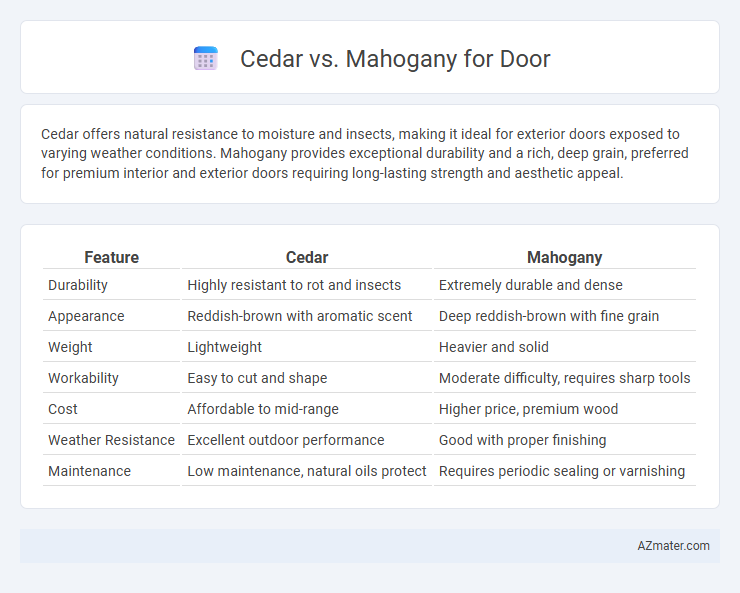Cedar offers natural resistance to moisture and insects, making it ideal for exterior doors exposed to varying weather conditions. Mahogany provides exceptional durability and a rich, deep grain, preferred for premium interior and exterior doors requiring long-lasting strength and aesthetic appeal.
Table of Comparison
| Feature | Cedar | Mahogany |
|---|---|---|
| Durability | Highly resistant to rot and insects | Extremely durable and dense |
| Appearance | Reddish-brown with aromatic scent | Deep reddish-brown with fine grain |
| Weight | Lightweight | Heavier and solid |
| Workability | Easy to cut and shape | Moderate difficulty, requires sharp tools |
| Cost | Affordable to mid-range | Higher price, premium wood |
| Weather Resistance | Excellent outdoor performance | Good with proper finishing |
| Maintenance | Low maintenance, natural oils protect | Requires periodic sealing or varnishing |
Introduction to Cedar and Mahogany Doors
Cedar doors are prized for their natural resistance to rot, insects, and moisture, making them ideal for exterior use in diverse climates. Mahogany doors offer exceptional durability and a rich, deep color with fine grain patterns, providing both elegance and structural strength. Both woods are favored for their stability, but cedar is known for its lightweight and aromatic qualities, while mahogany is heavier and renowned for its high density and classic appeal.
Appearance and Aesthetic Differences
Cedar doors showcase a warm, reddish-brown hue with a distinct, fine grain pattern that offers a rustic and natural charm, while mahogany doors feature a deeper, rich reddish-brown color with a smooth, straight grain that exudes elegance and sophistication. The natural oils in cedar provide a matte finish that enhances its rugged texture, contrasting with mahogany's ability to take on a high-gloss polish, emphasizing its luxurious sheen. These aesthetic differences make cedar ideal for casual, cozy designs and mahogany suited for formal, upscale architectural styles.
Durability and Lifespan Comparison
Cedar doors offer natural resistance to rot, decay, and insect damage, providing a lifespan of 15 to 30 years with proper maintenance, making them ideal for humid or coastal environments. Mahogany doors boast exceptional durability due to their dense, tight grain structure and high oil content, often lasting 40 to 50 years or more, even in harsh weather conditions. The superior hardness and resistance to warping in mahogany ensures long-term structural integrity and aesthetic appeal compared to cedar.
Resistance to Weather and Insects
Cedar doors offer superior resistance to weather due to their natural oils that repel moisture, reducing the risk of warping or rotting in humid or rainy climates. Mahogany, while durable and dense, requires regular sealing to maintain its resistance to insects and weather damage, as it is more prone to swelling and fungal attacks without treatment. For long-term outdoor durability, cedar is preferred for its inherent insect-repellent properties and better performance in fluctuating weather conditions.
Weight and Workability
Cedar doors are significantly lighter than mahogany, making them easier to handle and install, especially in larger sizes. Mahogany, while heavier, offers superior strength and durability but can be more challenging to work with due to its density and hardness. The lighter weight and softer grain of cedar make it more suitable for intricate carving and modifications, whereas mahogany requires specialized tools for detailed work.
Insulation and Energy Efficiency
Cedar doors offer superior insulation due to their natural thermal properties and lower density, helping reduce energy costs by maintaining indoor temperature more effectively. Mahogany provides moderate insulation but excels in durability and moisture resistance, which can contribute to long-term energy efficiency by preventing drafts and warping. Choosing cedar enhances energy savings in colder climates, while mahogany suits environments where durability and resistance to environmental factors are critical for insulation performance.
Maintenance Requirements
Cedar doors demand regular maintenance, including annual sealing or staining to prevent moisture damage and insect infestation, ensuring their natural resistance remains effective. Mahogany doors require less frequent upkeep due to their dense wood composition, but periodic polishing and re-sealing every 2-3 years help maintain their rich color and durability. Both woods benefit from proper weatherproofing to extend their lifespan and preserve aesthetic appeal.
Environmental Impact and Sustainability
Cedar doors offer greater environmental benefits due to their faster growth rate and renewable sourcing, making them a more sustainable choice compared to mahogany, which is often harvested from slower-growing tropical hardwood forests. Mahogany's environmental impact is significant because it is linked to deforestation and habitat loss in critical ecosystems, while cedar plantations typically have a lower ecological footprint. Choosing cedar supports sustainable forestry practices and helps reduce carbon emissions associated with deforestation.
Cost and Value for Money
Cedar doors typically cost less upfront than mahogany, with prices ranging from $300 to $700 compared to mahogany's $700 to $1500 per door. Cedar offers excellent durability and natural resistance to moisture and insects, making it a cost-effective choice for weather-prone areas while maintaining a warm aesthetic. Mahogany provides superior density and rich color that ages gracefully, delivering long-term value for money through enhanced durability and timeless appeal despite the higher initial investment.
Choosing the Right Wood for Your Door
Cedar offers natural resistance to rot and insects, making it an ideal choice for exterior doors in humid or rainy climates, while mahogany is prized for its rich color, durability, and fine grain, providing an elegant and long-lasting option for high-end doors. The stability and hardness of mahogany make it less prone to warping and dents compared to cedar, which is softer and may require more maintenance over time. Selecting between cedar and mahogany depends on climate conditions, aesthetic preferences, and budget considerations, with mahogany typically costing more but offering superior longevity and a luxurious appearance.

Infographic: Cedar vs Mahogany for Door
 azmater.com
azmater.com